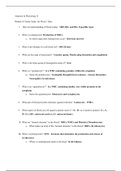Master of Nursing
Thompson River University (TRU )
All 16 results
Sort by
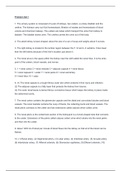
-
Anatomy and physiology II 102: Module 5 Exam with all problems sets, questions and answers
- Exam (elaborations) • 7 pages • 2021
-
- $17.49
- + learn more
Problem Set 1 1. The urinary system is composed of a pair of kidneys, two ureters, a urinary bladder and the urethra. The kidneys carry out fluid homeostasis, filtration of wastes and homeostasis of blood volume and chemical makeup. The ureters are tubes which transport the urine from kidney to bladder. The bladder stores urine. The urethra carries the urine out of the body. 2. The adult kidney is bean shaped, about the size of a can of soup and weighs about 5 ounces. 3. The right kidney is l...
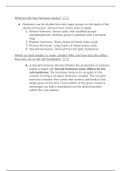
-
A&P Quiz 1 with explained answers and diagrams
- Exam (elaborations) • 6 pages • 2021
-
- $17.49
- + learn more
What are the four hormone classes? 17.2 ● Hormones can be divided into two major groups on the basis of the chemical structure- derived from amino acids or lipids 1. Amine Hormone- Amino acids with modified groups (norepinephrines carboxyl group is replaced with a benzene ring) 2. Peptide Hormone- Short chains of linked amino acids 3. Protein Hormone- Long chains of linked amino acids 4. Steroid Hormones- Derived from the lipid cholesterol Which are lipid soluble vs. water soluble? W...

-
Pharmacotherapeutics for advanced nurse practitioner prescribers - Chapter 48 Summary and Notes
- Summary • 18 pages • 2021
-
- $15.49
- + learn more
Overview Pharmacokinetics and pharmacodynamics in women Factors that influence medication administration Factors that influence positive outcomes Common problems Gay and lesbian health Women as Patients Prescribing during childbearing years Constant awareness of possible pregnancy Lactation requires careful prescribing. Women are at risk for violence. All women should be screened. Women live longer than men. Live alone Poverty Changes in cognitive and physical functioning...
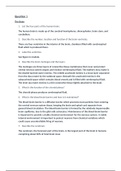
-
Anatomy and Physiology II 102: Chapter 2 question set, all problem sets, questions and answers
- Exam (elaborations) • 14 pages • 2021
-
- $14.49
- + learn more
Question 1 The Brain 1. List the four parts of the human brain. The human brain is made up of the cerebral hemispheres, diencephalon, brain stem, and cerebellum. 2. Describe the number, location and function of the brain ventricles. There are four ventricles in the interior of the brain, chambers filled with cerebrospinal fluid which is produced there. 3. Label the ventricles. See figure in module. 4. Describe the brain meninges and the layers. The meninges are three layers of connecti...
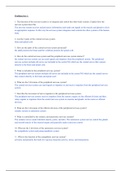
-
Anatomy & Physiology II 102: Module 1 Exam - all problem sets, questions and answers
- Exam (elaborations) • 14 pages • 2021
-
- $23.49
- + learn more
Problem Set 1: 1. The function of the nervous system is to integrate and control the other body systems. Explain how the nervous system does this. The nervous system receives and processes information and sends out signals to the muscle and glands to elicit an appropriate response. In this way the nervous system integrates and controls the other systems of the human body 2. List the 2 parts of the central nervous system. brain and spinal cord 3. How are the parts of the central nervous syst...
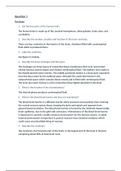
-
Anatomy & Physiology II 102: Chapter 2 Question Set
- Exam (elaborations) • 14 pages • 2021
-
- $17.49
- + learn more
Question 1 The Brain 1. List the four parts of the human brain. The human brain is made up of the cerebral hemispheres, diencephalon, brain stem, and cerebellum. 2. Describe the number, location and function of the brain ventricles. There are four ventricles in the interior of the brain, chambers filled with cerebrospinal fluid which is produced there. 3. Label the ventricles. See figure in module. 4. Describe the brain meninges and the layers. The meninges are three layers of connecti...
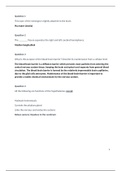
-
Anatomy and Physiology II 102: Module 2 test
- Exam (elaborations) • 12 pages • 2021
-
- $7.49
- + learn more
Question 1 This layer of the meninges is tightly attached to the brain. Pia mater (menix) Question 2 The _______ fissure separates the right and left cerebral hemispheres. Median longitudinal Question 3 What is the purpose of the blood-brain barrier? Describe its maintenance from a cellular level. The blood-brain barrier is a diffusion barrier which prevents most particles from entering the central nervous system tissue, keeping the brain and spinal cord separate from general blood...
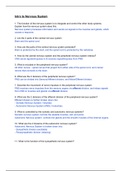
-
Anatomy and Physiology II 102: Neurology Review Questions (Intro to Nervous System)
- Exam (elaborations) • 32 pages • 2021
-
- $17.49
- + learn more
Intro to Nervous System 1. The function of the nervous system is to integrate and control the other body systems. Explain how the nervous system does this. Nervous system processes information and sends out signals to the muscles and glands, which causes a response. 2. List the 2 parts of the central nervous system. Brain and the spinal cord 3. How are the parts of the central nervous system protected? Brain is protected by the skull, and the spinal cord is protected by the vertebrae...
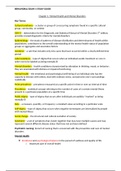
-
Behavioral Exam 1 Study Guide: Chapter 1: Mental Health and Mental Disorders
- Exam (elaborations) • 40 pages • 2021
-
- $17.49
- + learn more
Key Terms: Cultural syndrome – a cluster or group of co-occurring symptoms found in a specific cultural group, community, or context DSM-5 – abbreviation for the Diagnostic and Statistical Manual of Mental Disorders 5th edition; provides revised diagnostic criteria for mental disorders Epidemiology – the study of patterns of disease distribution and determinants of health within populations; contributes to the overall understanding of the mental health status of population groups or ag...

$6.50 for your textbook summary multiplied by 100 fellow students... Do the math: that's a lot of money! Don't be a thief of your own wallet and start uploading yours now. Discover all about earning on Stuvia

